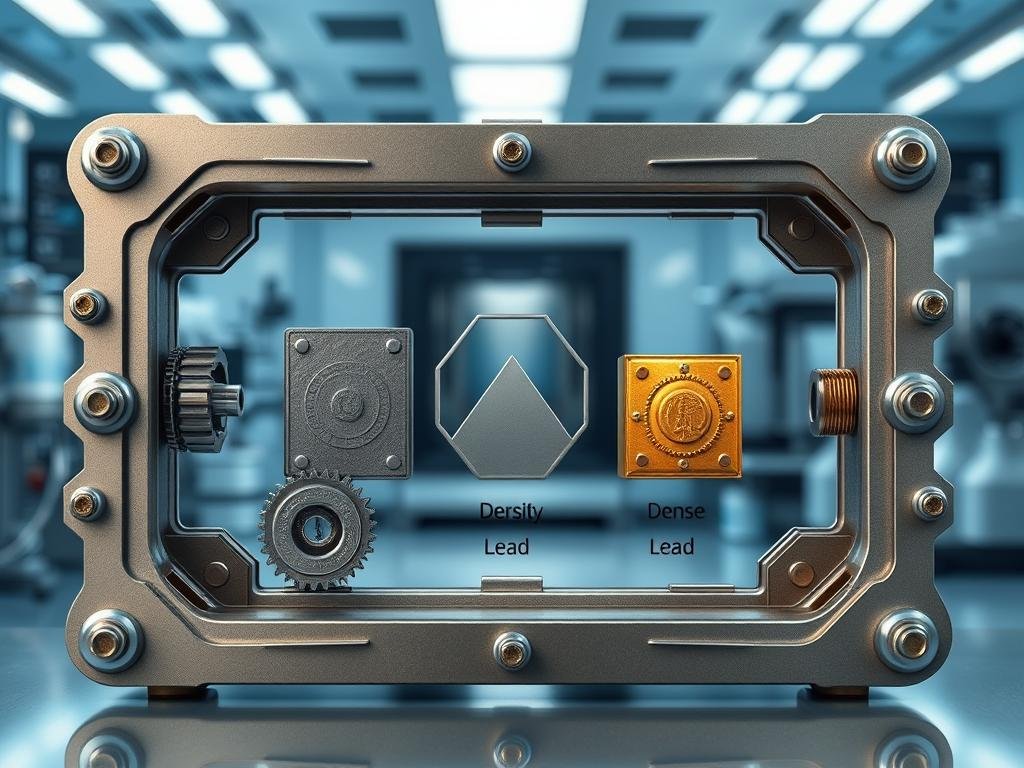理解的 密度 各種材料的密度在工程和科學應用中至關重要。密度,定義為物體的質量除以體積,是一個基本的性質,決定了不同材料在各種條件下的行為。
密度的概念在選擇適當的 material 用於特定應用,範圍從建造飛機到製作輻射屏蔽。不同的金屬元素展現出各種密度,從非常輕到極重。
By exploring the principles that govern density and examining how it varies across the periodic table, we can better understand why certain materials are preferred for particular uses. This knowledge is essential for advancing various technological and industrial applications.
理解金屬密度
金屬的密度差異很大,影響其在各行各業的應用。理解 金屬密度 is essential for selecting the appropriate metal for specific uses.
定義與計算
金屬密度被定義為每單位體積的金屬質量。計算公式為 ρ = m/V,其中 ρ 是密度,m 是質量,V 是體積。此公式提供任何金屬的密度值。
測量單位
密度通常以每立方米公斤數(kg/m³)或每立方公分克數(g/cm³)表示。其他單位包括每立方英尺磅數(lb/ft³)和每加侖盎司數(oz/gal),用於特定產業。
| 單位 | Equivalent |
|---|---|
| 1 kg/m³ | 0.001 g/cm³, 約0.06243 lb/ft³, 約0.1335 oz/gal |
| 1 g/cm³ | 1000 kg/m³, 1,000,000 g/m³ |
| 1 lb/ft³ | ≈16.02 kg/m³ |
| 1 oz/gal | ≈7.489 kg/m³ |

Understanding the different units of measurement and their conversion factors is crucial for working with metal density. This knowledge helps in accurately identifying and comparing the densities of various metals.
Lightweight Metals
Lightweight metals play a crucial role in modern industries, offering a unique combination of strength and low density. These metals are characterized by their low density values, typically below 5000 kg/m³.
Lithium, Magnesium, and Aluminum
Lithium, with a density of 534 kg/m³, is the lightest structural metal. Magnesium, at 1738 kg/m³, offers an excellent strength-to-weight ratio, making it valuable for automotive and aerospace applications. Aluminum and its alloys, with densities ranging from 2560-2830 kg/m³, balance low density with good corrosion resistance and formability.
低密度金屬的常見應用
The aerospace industry relies heavily on these low-density materials for fuel efficiency, with aluminum alloys comprising up to 80% of some aircraft structures. Modern technological advances have created specialized aluminum alloys like 7050 and 7178, offering enhanced strength while maintaining the weight advantage of lightweight metals.
- Lithium is used in batteries and other electronic components.
- Magnesium is used in automotive and aerospace applications.
- Aluminum alloys are used in aircraft structures and other industrial applications.
Heavyweight Metals
Heavyweight metals, characterized by their exceptionally high densities, are indispensable in numerous applications. These metals have densities exceeding 10,000 kg/m³, making them crucial for various industrial uses.
Precious and Industrial Heavyweights
Metals like gold (19,320 kg/m³), platinum (21,400 kg/m³), and tungsten (19,600 kg/m³) are among the heavyweights. Osmium, with a density of 22,610 kg/m³, is the densest naturally occurring metal, though its use is limited due to toxicity concerns.
工業應用
The high density of these metals makes them ideal for specific applications. Tungsten’s density is utilized in aerospace counterweights and radiation shielding. Gold’s density, combined with its malleability and resistance to corrosion, makes it valuable in electronics and dentistry.

| 金屬 | 密度 (kg/m³) | Density (lb/ft³) |
|---|---|---|
| 金 | 19,320 | 1,206 |
| Platinum | 21,400 | 1,336 |
| 鎢 | 19,600 | 1,224 |
| Osmium | 22,610 | 1,412 |
| Lead | 11,340 | 708 |
The unique properties of these heavyweight metals make them essential materials in various industries, from aerospace to electronics, due to their high metal density.
結論
The vast range of metal densities available today revolutionizes the field of material science. The spectrum of densities, from lithium’s 534 kg/m³ to osmium’s 22,610 kg/m³, offers diverse options for engineering applications. Understanding density enables engineers to balance weight and mechanical properties, while advances in metallurgy expand available alloys.
Environmental and economic factors drive the selection of materials, with lightweight metals gaining importance in transportation and electronics. Density remains a crucial consideration, guiding innovation across industries.
